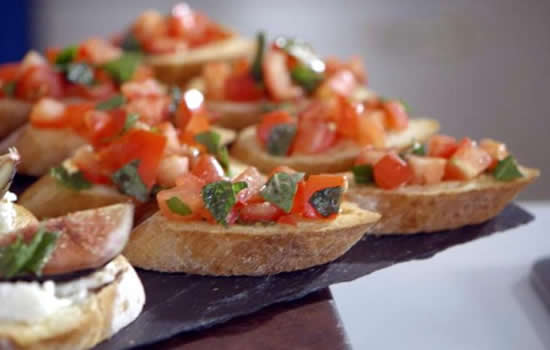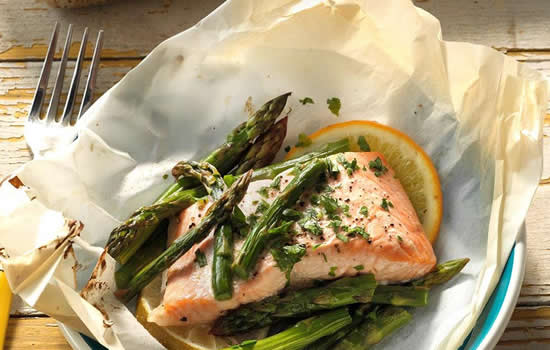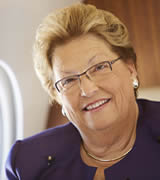Solving the menu terminology puzzle
How does one interpret a menu? What do all the terms mean? As a chef and foodie, I can generally recognize a cooking preparation simply by the terms used in the menu description. But what about the non- foodie? You may understand some, but, not all.
What do terms such as Aïoli mean? What terms on a menu might help you determine what foods will reheat best on the aircraft? Sometimes the name of the food might have absolutely nothing to do with the way the food was prepared.
We are always asking the flight crews, what have you had lately that you loved and would like to have again? What do you make at home and want us to prepare? I have found over the years that flight crews don’t always want restaurant food, but want something that makes them think of home. So on our menu, you might see something like a Mary M turkey sandwich. What does that name tell about the contents of that menu item . . . nothing. It simply means that a flight attendant named Mary M came up with a sandwich idea and since we also loved the combination of foods and it appealed to enough of you, we added it to our menu and named it after her.
One of our chefs makes the most incredible New Orleans shrimp Po boy; we named it after him. Foods may carry the name of the city they are prepared in, or may even be named after a hotel or chef that made the dish famous, for example, the Sacher torte.
So what food works best for reheating on a private jet? You need foods with moisture since the high altitude and the pressure changes inherent in aviation cooking lower the boiling point of water (which causes things to take longer to heat in the air than on the ground; and the longer the food sits in the oven the drier it becomes).
Some years ago, I was given a book called Food Lover’s Companion at a conference and it has now become a staple reference book in my library. Many of the terms I am going to define come directly from this handbook, with a few aviation notations I have added.
Some simple terminology to look for on your food sources menus or to ask your food source would be:
Aïoli Strongly flavored garlic mayonnaise, a popular accompaniment for fish, meats and vegetables. This is a common base for a cold sauce with additional flavor compounds added such as roasted red pepper which would then be called roasted red pepper Aïoli, or spinach which would then be called spinach Aïoli.
à la French meaning “in the manner or style of”. We in the United Sates frequently use this attached to mode, meaning served with ice cream. We will also us the prefix à la Dan to mean that it is prepared by Dan’s recipe which could be a totally different recipe than what one might expect. For example our menu might state Chicken Codon Blue à la Dan. So it may not have the normal ham and Swiss filling, but instead may have a substituted Turkey ham and gruyere filling with a thin layer of fresh spinach. So always ask the food source how their à la preparations style is handled. It will eliminate a lot of surprises.
À la Nage Cooking à la nage means poaching food, usually seafood, in a court bouillon and serving the court bouillon and the vegetables around the food as part the garnish. You see more of this as passengers are watching their diets and caloric intake. Generally this requires a flight crew member to assemble the plate on board.

Crayfish with dill à la nage.
à la carte Meaning each item is priced separately. Watch for this when ordering aircraft catering as many food sources will charge for each item; the meat alone, the vegetables alone, the starch alone, the bread alone, the salad alone and dessert alone, rather than as a complete meal. Don’t assume that when you order the Veal Masala is comes with anything other than the Veal. Every caterer and food source will have their own method of pricing and ordering. You may select an entrée and then select two vegetables from a list of suggestions as part of the price, but it may not include the salad or starter, dessert and rolls and butter. To prevent sticker shock, always ask what is included.
Al dente An Italian phrase meaning “to the tooth” used to describe pasta or other food cooked until it offers a slight resistance when bitten into. Often times, you hear someone request green beans al dente, meaning just cooked to crisp tender and not limp. Al dente vegetables have better color and will not turn into a mushy mess on the plate. This preparation is wonderful for aircraft because sound and texture are both key elements in planning an aircraft meal. The background noise of the aircraft does affect taste, so a crunch when you bite and a clean crisp color of vegetables will help stimulate the taste buds.
Béchamel A classic white sauce made with whole milk thickened with a white roux (flour and butter mixture), which can be flavored with aromatic vegetables, wines or other ingredients. It is frequently the base of a sauce offered by another name on the menu. Watch out for the gluten allergy and dairy allergy here as it may be hidden in the sauce.
Beurre Blanc A rich butter sauce made by whisking butter into a reduction of white wine, white wine vinegar, and shallots, and sometimes finished with fresh herbs or other seasoning. This sauce can “break” and separate if overheated on the aircraft.

The ingredients for Beurre Blanc.
Biscuit/ Cracker A source of some confusion between the food source and flight crews from around the world. In the United States, a cracker is a quick bread. They are generally savory and should be light and tender. In the British Isles, refers to a thin crisp cookie or cracker which can also be savory or sweet. Those of you coming to the US might have a surprise delivered if you order a biscuit and expect a cracker.
Blackened A popular Cajun cooking method in which seasoned fish or other foods are cooked over high heat in a super-heated heavy skillet until charred, resulting in a crisp, spicy crust. This is not something I suggest to prepare on an aircraft because of the smoke that occurs during the cooking process, but, the spicy flavor will definitely be a good addition for an aircraft meal.
Canapé Small, decorative pieces of bread (toasted or untoasted) that are topped with a savory garnish such as anchovy, cheese or some type of spread. Crackers or pastry may also be used as a base. Canapés may be simple or elaborate, hot or cold. They're usually served as an appetizer with cocktails. This word is used also for hors d’oeuvre, but these may or may not be served on a small bread or crouton. When hors d’oeuvre is requested it simply refers to a single bite of food.

Canapés
Crème Anglaise A dessert custard sauce or vanilla sauce. Sauces are great for aircraft meals as they can overcome the problem of foods which dry out when exposed to cabin air.
Chutney From the East Indian word chatni - this spicy condiment contains fruit, vinegar, sugar and spices. It can range in texture from chunky to smooth and in degrees of spiciness from mild to hot. The sweeter chutneys make interesting bread spreads and are delicious served with cheese. Chutneys are the perfect solution for the lighter version of a sauce to add that much needed moisture to a food.
Coulis A mixture - often a fruit puree - that has been strained of tiny seeds or pieces of peel so it is perfectly smooth. These can be sweet or savory and again the solution for adding that much needed moisture to a dish.
Deep-fry To cook food by completely covering with hot fat. Generally this cooking method does not reheat well and should be evaluated seriously before selecting for the aircraft. Although the type of crust used on a fried item will affect the quality when reheated on an aircraft, fried foods become soggy and often greasy when reheated.
Deglaze Adding a liquid such as water, wine, or broth to a skillet that has been used to cook meat. After the meat has been removed, the liquid is poured into the pan to help loosen the browned bits and make a flavorful sauce.
Demi-glace A thick, intense meat-flavor gel that's often used as a foundation for soups and sauces. This type of sauce base works wonderfully for an aircraft because the flavors are more intense than many other types of sauces.
Direct Grilling Method of quickly cooking food by placing it on a grill rack directly over the heat source, generally over some sort of wood or coals. Char grilling is often used on menus with this cooking method.
En Croute Enclosed in a bread or pastry crust. If you have an oven on board, this preparation works very nice. The protein and vegetables inside the pastry are steamed during the reheating process and will not dry out as much…but I do not recommend this if your reheating is a microwave as the crust will become limp and moist.

Salmon en Papillote
Papillote Food wrapped in parchment paper or aluminum foil and baked in an oven where it will steam in its own moisture and that of any vegetable added to the package to flavor the meat. When wrapped in parchment this makes a nice presentation for the aircraft, but, creates something on the plate that will need to be disposed of at the end of the flight. If this item was seafood or fish, you may find there is a smell lingering from the trash for the remainder of the flight.
Sabayon A light, frothy mixture made by beating egg yolks with water or other liquid over gentle heat. A wonderful sauce usually for desserts, but again this is a hidden allergen for eggs.
Salsa A sauce usually made from finely chopped tomatoes, onions, chiles, and cilantro. It is often used in Mexican and Southwestern cuisine. The trend now is fruit salsas such as mango, pineapple, papaya and other vegetable salsas such as a cucumber. Salsas are light and fresh.
Sauté Sautéed food is cooked and stirred in a small amount of fat over fairly high heat in an open, shallow pan. Food cut into uniform size sautés the best. Always ask what type of oil is used in the sauté process such as peanut oil, hazelnut oil, olive oil, etc.
Timbale A small pail-shaped mold used to shape rice, custards, mousselines, and other foods. This can be done on the aircraft by pressing rice, or other small grain items into a coffee cup and inverting on the plate. A quick fix for a presentation.
Vinaigrette The classic French salad dressing made of one part vinegar and three parts oil. Mustard and cream can be added if desired.
For more detailed information on cooking terminology refer to Food Lover’s Companion by Sharon Tyler Herbst.

BlueSky Business Aviation News | 1st August 2019 | Issue #521
Share this article
About Paula Kraft . . . Paula Kraft is the founding partner of the DaVinci Inflight Training Institute located in Fort Lauderdale, Florida and the founder/president of Tastefully Yours Catering, an aviation specific caterer, located in Atlanta, Georgia for over 35 years. Paula is active with many aviation and catering-related groups including the International Caterers Association, the International Inflight Food Service Association and is a board member of Women in Corporate Aviation. She is the past chair of the NBAA Flight Attendant Committee Caterer’s Working Group for 15 years perfecting unique catering training sessions for NBAA conferences and events. Currently, she serves on the NBAA Flight Attendant Advisory Committee and is a member of the Training and Safety Subcommittee. Paula was a founding member of the Steering committee for the creation of a European Flight Attendant Committee and conference and serves as a subject matter expert to the board of International Standard for Business Aircraft Handlers (IS-BAH). After founding Tastefully Yours Catering, she has been offering culinary and food safety related training to the general aviation community. With a strong dedication to improving catering safety, risk mitigation and safe food handling, she developed and introduced the concept of “catering safety management systems”. As a certified food safety instructor, Paula offers catering SMS and culinary classes for all aviation professionals. Paula’s first-hand experience, business acumen, research, and relationships make her an industry expert - one which allows her to share information that will help raise the professional training level for flight attendants today that will reduce the risk of food-related concerns tomorrow. From Paula . . . I have coordinated training programs and clinics for NBAA and EBAA conference attendees for over 10 years, created mentoring programs for caterers and flight attendants to broaden their aviation culinary skills, and to assist them in adapting to the unique challenges and constraints found in catering for general aviation. I recognize the need for training and have worked closely with flight departments, flight crews, schedulers and customer service reps at the FBOs to ensure that catering specific training provides information and skills necessary to reduce risk while assisting them in their job duties that include safe food handling, catering security, accurate transmission of food orders, and safe food production, packaging and delivery. I fell into aviation catering quite by accident. I was the in-house caterer and bakery supplier for Macy’s department stores in Atlanta when catering was ordered for a Macy’s customer which was soon to change my life. After the client enjoyed the catering provided, I was summoned to the client’s corporate office to provide several of the items delivered through Macy’s to the executive dining room. Within a week, I was providing food for the flight department and my first order was for the President of a foreign country (as I was too be told soon after). So, here I am, some 35 years later, still loving every minute of every day in aviation catering.
|
| © BlueSky Business Aviation News Ltd 2008-2019 |



